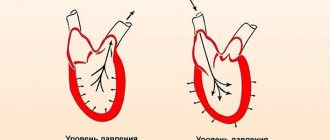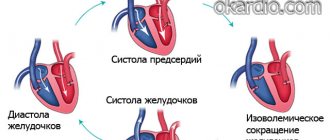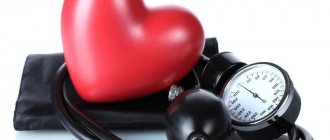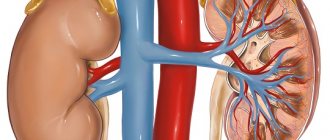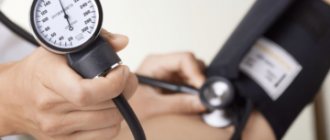Age-related changes in the human body are irreversible. We cannot turn back time, but we can control our own health and take measures to stabilize our well-being. One of the most important factors indicating health problems is blood pressure. They are influenced by: the general condition of the body, psycho-emotional factors, hormonal changes and, of course, the number of years lived. What is the normal blood pressure for a person by age, and what to do if the values on the tonometer are far from ideal?
How to measure blood pressure correctly?
Sometimes errors in pressure readings may be associated with improper use of a semi-automatic or automatic tonometer, most often used at home. It is important not only to check the functionality of the device, for example, the battery charge, but also to adhere to a number of simple rules, among which the following can be noted:
- You should not smoke before taking measurements. Of course, smoking, in principle, cannot be called a healthy habit, but if you smoke, try to give up cigarettes at least half an hour before the diagnostic procedure.
- Physical activity 30–60 minutes before measuring blood pressure (blood pressure) in an adult or child is also excluded. It is necessary to rest and relax, otherwise the indicators of the device will be inaccurate and can be misleading with sharply increased and decreased values.
- You should not eat shortly before measurement. Some foods can themselves raise blood pressure for a short time. A hearty dinner forces the body to work harder, which cannot but affect the results.
- Blood pressure should be measured in a sitting position, sitting on a chair with good back support. The hand should be at chest level (on the table). You cannot talk or gesture while the tonometer is working.
- For a more accurate measurement, it is necessary to measure blood pressure on one arm, and after 10 minutes - on the other. The lowest result will be accurate.
Advice! For both hypertension and hypotension, it will be useful to keep a journal in which data on blood pressure values and the time of measurements will be recorded.
Upper or systolic is the pressure at the moment when the heart muscle is at maximum tension, pushing blood into the arteries. Lower, or diastolic pressure at the time of diastole (rest). When making a diagnosis, not only the values themselves are taken into account, but also the difference between the upper and lower pressure, which normally does not exceed 20–40 mmHg. Art.
It is also important to take your heart rate into account. An increased or decreased pulse against a background of normal blood pressure may indicate a number of pathologies that require additional examination and treatment.
Increased diastolic pressure
Increased lower pressure often goes unnoticed in the first stages. When manifestations of such pathology become frequent, the patient goes to the doctor. Lost time can negatively affect the prognosis of the disease, so you need to contact doctors at the first signs of this disease.
Pathological reasons:
- The kidneys are one of the most important organs involved in regulating blood pressure, so the slightest malfunction in this system will immediately affect the tonometer readings. Kidney diseases: chronic glomerulonephritis, narrowing of the renal artery, renal failure, congenital defects in the structure of the blood vessels of this organ.
- Heart defect or tumor in this area.
- Thyroid diseases.
- Hormonal disorders, especially in women during pregnancy or menopause.
- Pathologies of the pituitary gland and adrenal glands, which provoke increased synthesis of hormones that affect blood pressure levels.
- Vertebral hernias.
It should be borne in mind that increased lower pressure may be a variant of the norm, since this index can change several times a day. Physical activity or emotional stress will certainly affect the tonometer data, namely the lower numbers.
Signs:
- disturbance of consciousness;
- nosebleeds;
- visual impairment in the form of blurred vision;
- difficulty breathing;
- swelling of tissues;
- headaches that occur frequently and last a long time;
- signs of other diseases that caused an increase in this index.
Often, the manifestations of this disorder in the body are completely absent; a person may not suspect such a malfunction in the body for a long time. It is necessary for all people to measure their blood pressure at least once a year in order to timely record deviations in the tonometer data, on which their future health depends.
The danger of this situation is that manifestations of the disease may be absent for a long time, and the disease progresses more and more. Many people mistakenly believe that only high blood pressure poses a danger, but this is not true. With this pathology, the heart is under constant tension and relaxation almost never occurs. This leads to disruption of the blood supply to the organ, and then structural changes begin that cannot be reversed.
Every person needs to evaluate the importance of this indicator, because ignoring increased diastolic pressure for a long time significantly increases the risk of stroke, vein thrombosis, and heart attack.
In addition to drug treatment for this disease, you must follow some additional doctor's instructions.
Recommendations:
- balanced and proper diet;
- carefully regulate your daily routine, improve sleep, and get proper rest;
- reduce body weight if you are overweight;
- playing sports;
- taking medications and using traditional methods of therapy.
You can find out what low blood pressure means at an appointment with your doctor. If the doctor tells the patient about the importance of this indicator, then the person will take this situation seriously.
Blood pressure standards for children and adolescents
In newborn children, the vessels are elastic and soft. That is why the blood pressure in children is always reduced. Blood simply does not have to make any effort to be transported throughout the body. With age, under the influence of internal and external factors, the picture changes. The vessels become stiffer, the pressure is higher.
Blood pressure table for children and adolescents
If in the first weeks of life the normal pressure is 80 to 40 mm Hg. Art. with a heart rate of 140 beats per minute, then by the age of one year the values increase to 100 per 60 mm Hg. Art., and the pulse rate decreases to 132. In adolescence, blood pressure levels are not much lower than in adults, however, hormonal changes during puberty can lead to an increase in systolic and diastolic pressure or a decrease in the range of 15–20 mm Hg. Art. from the norm. Such fluctuations are not traditionally treated by adjusting the daily routine and diet. Blood pressure returns to normal by the age of 16. The heart rate of a teenager from 12 to 16 years old is 75 beats per minute.
Adjust individually
The question of whether it is possible to adjust indicators separately is also of concern to many. “Basically, all the drugs that we use to correct high blood pressure act on both upper and lower pressure. However, among the classes of antihypertensive drugs, we have the opportunity to select drugs with a predominant effect on systolic or diastolic pressure. Therefore, it is possible to implement a personalized approach to the patient based on his needs,” notes Maria Benevskaya.
For example, she says, medications that have a vasodilating effect will be more likely to cause a decrease in diastolic (lower) blood pressure. And drugs that reduce the force of heart contractions will reduce systolic (upper) blood pressure to a greater extent.
What numbers are normal for an adult?
Adult standards also change over time. The ideal value is 120/80 mmHg. Art., in fact, is a reference only for young people leading a healthy lifestyle. And what is the norm for 30 years old is irrelevant for a person at 70–80 years old.
Normal blood pressure and pulse rates by age for women and men:
| Age | Women, mmHg Art. | Men, mmHg Art. |
| 20 years | 116/72 | 123/76 |
| from 21 to 30 years old | 120/75 | 126/79 |
| from 31 to 40 years old | 127/80 | 129/81 |
| from 41 to 50 years | 137/84 | 135/83 |
| from 51 to 60 years old | 144/85 | 142/85 |
| 70 years and older | 159/85 | 142/80 |
The average heart rate for adults is 60–80 beats per minute. However, this indicator, like blood pressure, is influenced by external and internal factors: diseases, stress, excess weight, bad habits, weather, etc. There are also age standards. For a forty-year-old person, the heart rate is 80 beats per minute, which is the norm, and for a 70-year-old, the normal pulse is 90. It is important to pay attention not only to the number, but also to the rhythm of the pulsating beats.
Importance of indicators
So is it possible to conclude which of these indicators is more important? “As we have already figured out, each of these parameters has its own meaning, so they are both important. Currently, it is also customary to distinguish between isolated systolic hypertension, when only the upper pressure is increased, and isolated diastolic hypertension when only the lower pressure is increased. Each of these forms has its own prognostic significance and some features in treatment, so it is necessary to approach the identification and correction of these types of hypertension with equal attention,” notes Maria Benevskaya.
What are the reasons for fluctuations in blood pressure and heart rate?
The reasons for an increase or decrease in a person’s heart rate and blood pressure may be physiological. For example, associated with hypothermia, dehydration or living in high mountains, stress, and a sedentary lifestyle. Women especially often experience changes for physiological reasons. Fluctuations in blood pressure are considered normal not only during pregnancy or menopause, but also during menstruation. According to statistics, on the first day of menstruation, blood pressure decreases by 10 mmHg. Art. from the norm for age.
The blood pressure of a 9 year old child is normal
If deviations in blood pressure and pulse pressure differ significantly from the norm, you should contact a specialist (pediatrician, therapist or cardiologist), who will prescribe an additional examination that can explain why this problem arose. The reasons may be the following:
- disruption of the heart, which does not allow the organ to work with the necessary force;
- changes in blood composition caused by endocrine and autoimmune pathologies;
- atherosclerosis, in which cholesterol plaques form on the walls of blood vessels;
- a decrease in the elasticity of blood vessels or a decrease in the lumens in them, associated with age, hormonal processes in the body, taking medications, intense physical activity, and nutritional disorders.
The risk of hypertension increases in overweight people
What is blood pressure?
Tonometers record the blood pressure on the walls of the arteries, which is why it is called arterial pressure. In other words, the indicator means how much the level of fluid pressure in the circulatory system is higher than atmospheric pressure.
If we describe the whole process in simple words, it will look like this:
- The heart muscle contracts;
- The aortic valve closes;
- The heart receives highly oxygenated blood from the lungs;
- The following reduction occurs;
- Blood moves to all organs.
The entire circulatory system is involved in the formation of blood pressure, including the blood itself, which supplies tissues with oxygen, removes waste products, and provides thermoregulation. BP shows how well these functions are performed.
Characteristic symptoms of hypertension and hypotension
At the first stage of hypertension, pressure surges up to 159/99 mm Hg occur. Art. Most often, malaise occurs after severe overwork or stress. Patients note an increase in heart rate and headaches, weakness, and increased nervous excitability.
At the second stage, the following symptoms include: deterioration of sleep, nosebleeds, pain in the heart, severe headaches. Blood pressure rises to 160–170/100–109 mmHg. Art.
The third stage of hypertension is a serious disease that irreversibly affects the entire human body. This stage is characterized by cardiac dysfunction, chronic renal and heart failure, heart attack, and angina.
Important! If at the first stage the patient’s condition can be corrected and the disease goes away almost without a trace, but stages 2 and 3 of hypertension are practically not curable. The goal of the doctor and his patient is to monitor the condition and regularly take antihypertensive drugs that can stabilize the patient’s well-being for some time.
Low blood pressure manifests itself differently. A person suffers from headaches, which are localized in the temporal region, loss of strength, drowsiness, dizziness, nausea, and fainting. Symptoms worsen during weather changes, magnetic storms, and during acclimatization.
Both hypertension and hypotension require treatment. What it will be like and how long it will last depends on the patient’s health condition. It is necessary to strictly adhere to the treatment regimen drawn up by the doctor, without independently increasing or decreasing the dosage of drugs.
Symptoms of low blood pressure
Most doctors consider chronic low blood pressure to be dangerous only if it causes noticeable signs and symptoms, such as:
- Dizziness
- Nausea
- Fainting
- Dehydration and unusual thirst
- Lack of concentration
- Blurred vision
- Cold, clammy, pale skin
- Rapid breathing
- Fatigue
- Depression
A single deviation from normal blood pressure readings is not a cause for concern unless you are experiencing any other symptoms.
Prevention measures
Age factors cannot be eliminated. However, a person of any age can delay the onset of cardiovascular diseases. To do this, you should adhere to certain rules, which should not be temporary, but permanent, even for a completely healthy person.
- Smoking and alcohol abuse are the main enemies of the heart and blood vessels. By getting rid of bad habits, you can protect yourself for a long time from problems with changes in blood pressure and their consequences.
- No matter how busy your work schedule is, make time for physical activity. If it is not possible to go to the gym, walking in the fresh air and morning exercises can be an alternative.
- In both adults and children, problems with blood pressure can be associated with stress and overwork, which occur in people of any gender and occupation. It is important not only to study and work fruitfully, but also to fully relax. Night rest is especially valuable, so you should refrain from working at night.
- Pay attention to weight. Every extra kilogram increases the load on the heart and blood vessels, which cannot but affect blood pressure. A balanced diet and regular physical activity will not only improve your figure, but also protect against changes in blood pressure.
- The condition of the heart and blood vessels largely depends on what food predominates in your diet. Eating disorders can lead to the formation of cholesterol plaques - the first step to hypertension. The menu should consist of lean meat, sea fish, cereals, whole grain bread, fruits, vegetables, and vegetable oils.
Important! Treatment of diseases - chronic and acute - must be timely. Regular visits to doctors will allow you to prolong your youth and avoid many problems with both blood pressure and the functioning of internal organs and systems.
What does the change in indicators depend on?
The permissible minimum difference between the upper and lower values, as well as the normal blood pressure for people depending on age, will be described below. But the reasons for the jumps in these numbers can be various reasons. As a result of numerous studies, it has been proven that the standard of living, external factors and health status in general affect the results of blood pressure assessment.
If for one person an increase in indicators by 10–20 units is considered normal, then for another it can turn into a disaster.
In 90% of cases, overestimation of blood pressure is recorded in obese people, and age also affects blood pressure levels. In an elderly person, blood vessels lose their former elasticity, and the body as a whole and the cardiovascular system in particular undergo age-related changes - as a result, blood pressure increases. However, over the past decades, signs of persistent hypertension have also been observed in very young people aged 30–35 years.
No ads 2
The following factors influence this:
- nature of the diet;
- bad habits (smoking and alcohol abuse);
- lack of proper rest;
- excessive brain and physical activity, leading to exhaustion of the body;
- emotional overload and frequent stressful situations.
If the pressure is increased by 10–20 units after intense physical activity (sports, carrying heavy weights), this is absolutely normal and, after a while, the indicators will return to the initial values on their own. Blood pressure is usually reduced during sleep and immediately after waking up, since the body is in a state of rest and relaxation.
Completing all vital processes, before going to bed, the body also reacts with a jump in blood pressure by 10–20 units. Low blood pressure occurs in women during the menstrual cycle, during pregnancy, and in men during colds.
What measures should be taken to control blood pressure
In fact, the simplest measures can help protect the body from many problems. You need to eat food that contains a minimum of salt, stop smoking, play sports - even moderate physical activity will help the body be in good shape, which will have a beneficial effect on the condition of the circulatory system.
It is important to minimize stressors and avoid irritants. Constantly monitoring your blood pressure is also a good habit. Under no circumstances should you take medications without a doctor’s prescription.
Much attention should be paid to the issue of stress. With daily negative psychological impact, a person must compensate for stress with physical activity. It has been proven that with physical activity, cortisol levels are significantly reduced. Training should be regular, as it allows the body to enter a certain mode and maintain it. The intensity doesn't have to be high.
What device is used to record pressure?
To monitor the blood pressure, a tonometer is used. There are automatic and semi-automatic devices. There are also mechanical ones. They use a rubber bulb. Despite the widespread use of automatic and semi-automatic tonometers, doctors resort to mechanical analogues, as they allow them to obtain the most accurate information. This involves using a phonendoscope to listen to the contraction of the arteries.
Which blood pressure monitor should you buy? This will depend on the frequency of use. If you plan to use the device infrequently, you can select the automatic (semi-automatic option). This device has the option of saving measurements, a timer, a convenient display showing indicators, a calendar and various technologies. However, it will have to be calibrated regularly, batteries will need to be changed, and the service life is relatively short. If you need to use a tonometer every day, it is better to purchase a mechanical analogue. Of course, it is not so comfortable, but it is practical. There are enough manufacturers on the market producing various tonometers. Among them are Rossmax, A&D, Microlife, Omron. Many semi-automatic and automatic models are reliable, although quite expensive. However, they can help to correctly interpret the indicators and even prevent dangerous consequences.
Danger to organs and body systems
- Heart. Due to the increased load, the walls of the myocardium begin to grow, especially the left ventricle, which works to eject blood. With tissue hypertrophy, nutritional deficiency begins, wear accelerates, and elasticity decreases. As a result, arrhythmia, bradycardia, ischemia, and heart attack may develop.
- Vessels. Constant tension makes blood vessels fragile, deforms them, and leads to ruptures. Hypertension increases atherosclerotic deposits, up to complete blockage. First of all, the capillaries that provide nutrition to the internal organs, eyes, and limbs are affected.
- Brain. Insufficient brain nutrition in hypertension leads to cognitive impairment. The most common cause of strokes is hypertension.
- Kidneys. Lack of blood circulation leads to the accumulation of toxins. The kidneys cannot cope with excretion in full; they do not have enough nutrients to recover. This leads to the development of kidney failure and further worsens the condition of blood vessels, as harmful compounds remain in the blood.
- Eyes. Hypertension can cause damage to the optic nerve, and in the most severe cases, blindness occurs.
What effect does alcohol have?
Many people believe that drinking alcohol helps lower blood pressure. However, here it is necessary to remember that we are talking about vasodilation, which does not necessarily play a positive role. Alcohol should be consumed in moderation.
Regular drinking of alcoholic beverages, even in small quantities, can increase blood pressure. You should also remember about the biologically active substances contained in many alcoholic beverages. Energy drinks pose a high risk to the human body. Combining them with alcohol can lead to the most harmful consequences.


